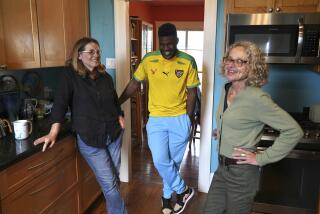Refugee Faces Change Over Years, but Rescue Group’s Mission Stays Same
- Share via
NEW YORK — Alarmed by war clouds forming over Europe, a small group of prominent citizens convened by Albert Einstein met in an apartment here in 1933 to plot the escape of opponents to Adolf Hitler.
Out of that meeting, the International Rescue Committee was born. And since its founding, the committee has faced a never-ending procession: People pedaling bicycles, drivers in cars overflowing with belongings, walkers bent with fatigue, the starving, mothers clutching babies, old men and women pushing carts--a caravan of terror and tears.
“The fact that it has taken different forms over the decades, affected different populations, different nations, gotten into different dramas is less important than the consistency of the plight of innocent human beings caught up in civil or military conflict,” said Reynold Levy, the IRC’s president and chief executive officer.
Over more than six decades, the IRC has resettled more than 250,000 people. Although the number is impressive, experts including Levy say it must be judged against the scope of the problem.
According to the U.N. high commissioner for refugees, one in every 115 people in the world has been forced to leave a homeland because of fear of death or persecution. It is estimated more than 17 million refugees currently struggle for existence.
The United States admits about 75,000 refugees a year, about 60% of the total resettled.
“The predominant way of dealing with refugees is to deal with them in the host country they happen to find themselves or repatriating them into their country of origin,” Levy said. “That’s how 99% of the world’s refugee problems are solved.
“We have huge numbers of refugees throughout Africa, enormous growth in our African operations as a result of Rwanda, Burundi, the Congo--very substantial crises in West Africa,” Levy added.
The African problems come atop major refugee emergencies in portions of the old Soviet Union and Pakistan, where people fearing for their lives in the Afghan war have fled. In Thailand, there is an influx of Burmese citizens. In Kosovo, ethnic Albanians have fled villages attacked by Serbian troops.
“We need to move quickly in a wide variety of circumstances to save lives,” Levy said in an interview at the committee’s headquarters here. “There is, alas, a lot more to do . . . than resources allow.”
Often, the simplest comforts can mean the difference between life and death for people seeking to escape persecution.
“For me to go to Burundi and look at the difference between a camp where there is just basic water and sanitation and a comparable camp where there is no water and sanitation, is at the age of 53 to develop a whole new appreciation for the noun called water and what it represents to human life,” Levy said.
“What [water] represents is that discernible energy level of a child, a camp in which children play and a camp in which children simply sit under a tree because there is no water. . . . How little, relatively speaking, in Western terms it takes to supply that water to those children.”
These days, the IRC is engaged on two fronts: Trying to help streamline the screening process for refugees seeking asylum in the United States while speeding up relief efforts for the vast majority who will remain overseas.
At the same time, it is concerned that fiscal constraints will further widen the gap between the number of people authorized to enter the United States and those who are actually admitted.
According to the United Nations, a refugee is defined as someone who flees because of a “well-founded fear” of persecution because of race, religion, nationality, social group or political opinion.
The resettlement process is conducted on a case-by-case basis, Levy said. “It is a slow process. It is a tedious process. It requires Immigration and Naturalization Service approval. . . . We have a staffer going out to West Africa with a congressional delegation who is an expert on refugee processing.
“Part of her mission is to figure out ways we can be helpful to the State Department in the identification of African refugees who are eligible for resettlement.”
Those who arrive in the United States follow distinguished footsteps.
Artists Marc Chagall, Salvador Dali, Wassily Kandinsky, architects Walter Gropius and Ludwig Mies van der Rohe, Nobel Prize winner Elie Wiesel, Secretary of State Madeleine Albright, Intel Chairman Andrew Grove and dancer Mikhail Baryshnikov are among the thousands of refugees who have left their imprint on America.
Many newcomers, who arrive with few belongings, find the road to self-sufficiency at first can be hard.
“The first thing they ask when they come to New York is where is the Statue of Liberty,” said Cliff Rames, director of IRC’s resettlement office in Manhattan.
“Six months later, they are working and they are happy. They buy a new TV or they just bought a car and they are taking field trips on weekends,” Rames added. “They have found a new life. It is very rewarding to know you played a part in that.”
More to Read
Sign up for Essential California
The most important California stories and recommendations in your inbox every morning.
You may occasionally receive promotional content from the Los Angeles Times.










